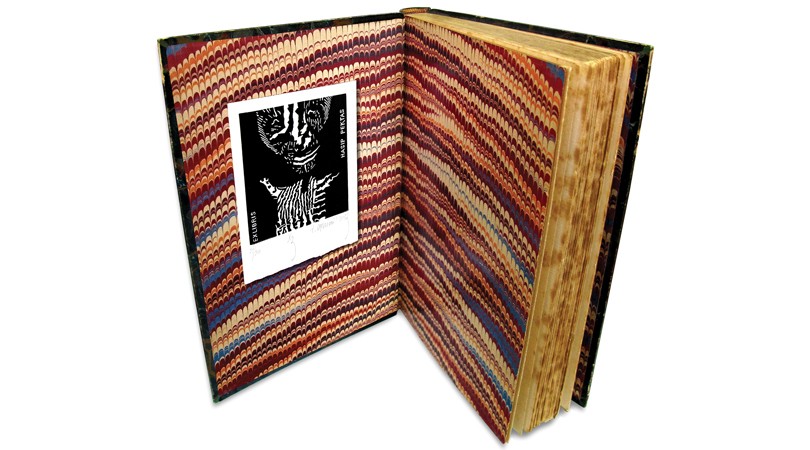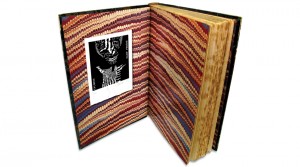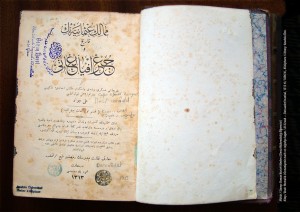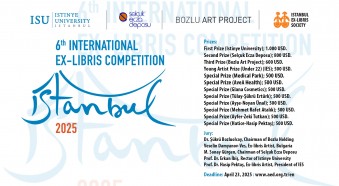What is Ex-libris?
Prof. Dr. Hasip Pektaş*
Ex-libris is a branch of art that introduces and glorifies the book owner. Ex-libris are small-sized prints that book lovers paste on the inside cover of their books, with their names and pictures on different subjects. It literally means from …’s library, belonging to …’s library. It is the business card or title deed of the book. It introduces and glorifies the owner of the book and warns the borrower to return it. Ex-libris is an important communication tool. Although it was born as a necessity graphic, they are original works made with aesthetic concerns.
It brings art between people’s hands, into books, and makes them feel its mesmerising warmth.
Ex-librises are made to order for the living person or institution, reflecting their characteristics.
When we look at the creation process, it is seen that all the possibilities of the art of painting are used. When we look at its functional side, it can be considered as a graphic design product.
It is known that the first and oldest example of ex-libris was made on a tile in 1400 BC and was attached to the chests containing the papyrus rolls of the Egyptian king Amenhophis III.
In 1450, the first ex-libris on paper was made for the German priest Johannes Knabenberg, known by the nickname “Igler” (hedgehog). The ex-libris depicting a hedgehog biting a flower reads “Hans Igler can kiss you”.
Ex-libris in the real sense started to be made with the invention of the printing press.
Later, ex-libris began to be used not only for pasting on books, but also as objects of accumulation and exchange. It ceased to be a book-specific sign and became independent as an original graphic work.
From the 19th century onwards, associations began to publish bulletins, books, address lists and organise competitions for the exchange.
The long side of the ex-libris should not be larger than 13 cm. and should be reproduced and numbered as in printmaking. For reproduction, engraving/C3, wood printing/X2, linoleum printing/X3, lithography/L, serigraphy/S, offset/P7, photography/P8, computer-aided design/CGD are used.
Ex-libris in Turkey has been recognised with books bought from the West. Books with ex-libris, which are widely used in European countries, came to our country through second-hand sales, and when the owners of the books died, they were donated to libraries by their relatives or sold to booksellers.
Although the seals seen on manuscripts and printed books from the Ottoman period are accepted as a sign of ownership, they do not belong to the ex-libris type. However, with their unique calligraphic structures, they fulfilled this function as the coat of arms or logo of the people they belonged to.
In our country, since the 2000s, young people who make ex-libris have started to be trained especially in institutions where art and design education is given. Ex-libris design is taught as a course in 7 universities, including Istinye University. Universities and municipalities organise ex-libris competitions. Artists now open solo exhibitions and win awards in international competitions. There are 27 postgraduate theses on ex-libris. The only thing that is lacking is ex-libris collecting.
Nowadays, our artists and designers open personal ex-libris exhibitions, participate in international competitions and receive awards. The biggest deficiency in our country is ex-libris collecting.
Founded in Ankara in 1997, the Ex-libris Association now continues its activities in Istanbul. One of the 10 museums in the world, Istanbul Ex-libris Museum, with its collection of over 12,500 ex-libris, is located at Selçuk Ecza Holding, Altunizade, Mahir İz Cad. 45 Üsküdar address, awaits the interest of art lovers.
Ex-libris exhibitions have been held in 14 cities in our country and in Germany, Belgium, Belarus, China, Denmark, Finland, Italy, Canada and Russia.
Five international ex-libris competitions have been organised and the XXXIIIth FISAE International Ex-libris Congress was held in 2010 with the participation of 280 people from 40 countries.
* Istinye University, Faculty of Communication, Department of Visual Communication Design,
President of Istanbul Ex-libris Association, Founder of Istanbul Ex-libris Museum







Leave a reply